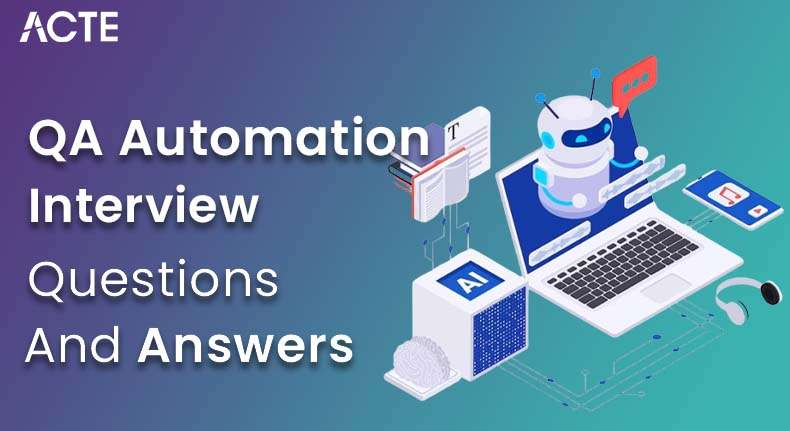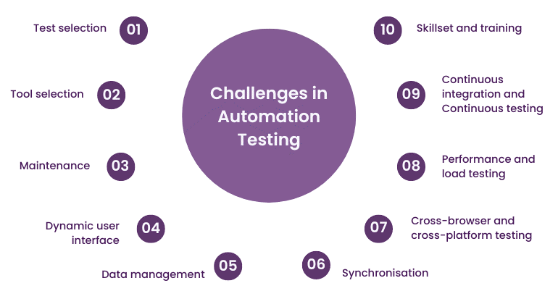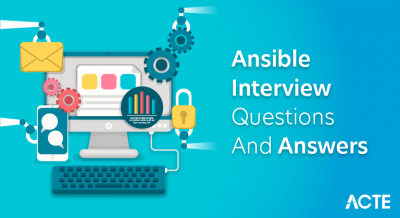
Automation in software testing refers to the use of specialized tools and scripts to perform testing tasks that would otherwise be carried out manually. It aims to increase the efficiency, effectiveness, and coverage of testing efforts while reducing human error and repetitive tasks. Automation can be applied across various testing levels, including unit testing, integration testing, system testing, and regression testing.
1. What is automation testing, and why is it important?
Ans:
Automation testing uses specialized software to execute pre-written tests on an application. Its main objective is to minimize manual testing effort, boost testing efficiency and effectiveness, and confirm the application’s functionality. Importance of Automation testing is crucial because it enhances accuracy by eliminating human errors, accelerates test execution, allows extensive testing through frequent and repetitive execution, and reduces costs.
2. Describe the differences between manual testing and automation testing.
Ans:
| Aspect | Manual Testing | Automation Testing |
|---|---|---|
| Execution | Test cases are executed manually by a human tester without the use of scripts or tools. | Test cases are executed using automated tools and scripts. |
| Accuracy | Prone to human error and inconsistencies due to manual execution. | High accuracy and consistency as tests are executed by scripts. |
| Speed | Time-consuming, especially for repetitive and regression tests. | Much faster, especially for repetitive and regression tests, due to automation. |
| Cost | Lower initial cost but higher long-term cost due to ongoing labor. | Higher initial cost due to tool and script development but lower long-term cost due to reduced manual effort. |
3. What is Quality Assurance?
Ans:
The methodical process of quality assurance, or QA, verifies that goods and services adhere to predetermined guidelines and standards. Throughout the development cycle, it entails routine testing, monitoring, and inspections to find and fix problems early. Quality assurance (QA) reduces costs related to errors and rework, boosts customer happiness, and improves product reliability by prioritizing prevention over detection.
4. What challenges are encountered with automation testing?
Ans:
- Initial Investment: High initial cost for tools and script development.
- Maintenance: Scripts must be updated regularly to reflect application changes.
- Skill Requirement: Requires technical skills for writing and maintaining scripts.
- False Positives/Negatives: Automated tests can produce misleading results if not properly managed.

5. How to decide which test cases to automate?
Ans:
- Repetitive Tasks: Ideal for frequently executed tests.
- High-Risk Areas: Critical functionalities that must consistently work.
- Stable Features: Features that stay mostly the same.
- Complex Calculations: Areas where manual testing is prone to errors.
- Large Data Sets: Tests requiring validation with extensive data.
- Regression Testing: Tests that need re-running with each new release.
6. What is the ROI of automation testing?
Ans:
Return on Investment (ROI) in automation testing is measured by comparing the costs of automation (tools, script development, maintenance) with the benefits (time savings, increased test coverage, reduced defects). A high ROI is achieved when the efficiency gains and cost savings outweigh the initial and ongoing costs of automation. Metrics include reduced test execution time, faster time-to-market, improved quality, and increased test coverage.
7. What is a framework for test automation?
Ans:
A systematic set of rules, known as a test automation framework, best practices, and tools designed to facilitate the creation, execution, and management of automated test scripts. It provides a standardized way to write and organize tests, improve code reuse, reduce maintenance effort, and ensure consistency. These frameworks, such as modular, data-driven, keyword-driven, and hybrid, are adaptable to different testing needs and environments.
8. Describe the different types of automation frameworks.
Ans:
- Linear Scripting: Simple record-and-playback model with linear script recording, suitable for small applications but hard to maintain.
- Modular Testing: Breaks the application into smaller, manageable modules, each tested independently.
- Data-Driven Framework: Uses external data sources (e.g., Excel, CSV) to drive tests, allowing the same test to run with different data sets.
- Keyword-Driven Framework: Uses keywords to represent actions on the application, making tests more readable and maintainable.
- Hybrid Framework: Combines elements from multiple frameworks to leverage their respective benefits.
9. What are the components of a good automation framework?
Ans:
- Reusable Functions
- Data Management
- Reporting
- Exception Handling
- Integration
- Scalability
- Maintainability
10. Explain the Page Object Model (POM) and its benefits.
Ans:
A design pattern called the Page Object Model (POM) is used in test automation to give online UI elements an organized approach to be managed. All of the pages are represented as classes in the object repository that is created. Within the class, interactions with these components are contained in methods. Better encapsulation, increased maintainability, increased reusability, and improved readability of test scripts.
11. How to handle test data in automation framework?
Ans:
Managing test data in an automation framework involves using various strategies to ensure data is manageable and reusable. This includes using external data sources like CSV files, Excel sheets, or databases, which are read during test execution. Data-driven testing frameworks allow tests to run with different data sets, enhancing flexibility. Separate data sets for different environments (development, QA, production) ensure appropriate data usage.
12. Describe a custom automation framework designed.
Ans:
Developed a custom hybrid automation framework that combines data-driven and keyword-driven methodologies. This framework featured a modular structure, breaking down the application into reusable components, and used the Page Object Model (POM) to organize web elements and their interactions, making maintenance easier. Test data was managed through Excel sheets, allowing for easy updates and scalability.
13. What programming languages are for automation?
Ans:
Several programming languages used in automation. Including of Java, widely used with Selenium for building robust automation frameworks; Python, for its simplicity and extensive libraries, often used with tools like PyTest and Robot Framework; JavaScript, used with frameworks like Protractor and Cypress for front-end testing; C#, used with Selenium for automating .NET applications; and Ruby, often used with Cucumber for behavior-driven development.
14. Write a simple script to open a web browser and navigate to a URL.
Ans:
- from selenium import webdriver
- # Initialize the WebDriver
- driver = webdriver.Chrome()
- # Open the browser and navigate to the URL
- driver.get(“https://www.example.com”)
- # Close the browser
- driver.quit()
15. How to handle exceptions in scripts?
Ans:
- Exception handling in automation scripts involves using try-catch blocks to manage errors gracefully and maintain script robustness.
- This includes wrapping potentially error-prone code in try-catch blocks to catch and handle exceptions, performing necessary cleanup, and maintaining script stability.
- Implementing logging mechanisms records exceptions and their details, aiding in debugging and analysis.
16. Explain the concept of synchronization in automation.
Ans:
Synchronization in automation ensures that test scripts wait for certain conditions to be met before proceeding, avoiding issues such as trying to interact with elements that are not yet available. Techniques include implicit waits, which set a default wait time for all elements in the script, and explicit waits, which wait for specific conditions before continuing. Fluent waits poll for a condition at regular intervals, allowing for custom timeout and polling periods.
17. What is a regular expression, and how is it useful in test automation?
Ans:
A regular expression A string of characters known as (regex) establishes a search pattern and is used for string matching and manipulation. In test automation, regex is useful for validating input formats, including phone numbers and email addresses, guaranteeing they meet specific criteria. It also helps in text extraction, allowing specific patterns to be extracted from larger strings, like extracting order numbers from confirmation messages.
18. Describe a scenario where multithreading was necessary in an automation script.
Ans:
- In a performance testing project, utilized multithreading to simulate concurrent user actions on a web application.
- By creating multiple threads, each representing a user session, able to generate a realistic load and measure the application’s performance under stress.
- These threads executed the same set of actions simultaneously, providing insights into response times, throughput, and potential bottlenecks.
19. What automation tools have been used?
Ans:
Experience with a variety of automation tools, each suited for different testing needs. Selenium is my primary tool for web application testing due to its flexibility and widespread support. For mobile application testing, I use Appium, which supports both Android and iOS platforms. Jenkins is my go-to for continuous integration and continuous deployment (CI/CD), automating the execution of tests upon code commits.
20. How do Selenium and QTP/UFT compare?
Ans:
Selenium and QTP/UFT are widely used automation tools, each offering unique advantages. Selenium is an open-source framework designed mainly for testing online applications. It is compatible with several computer languages, including Java, Python, and C#, and works with browsers like Chrome, Firefox, and Internet Explorer. QuickTest Professional, now known as Unified Functional Testing, is a commercial tool from Micro Focus.
21. Describe Appium and indicate when it utilized.
Ans:
- An open-source program called Appium is used to automate testing of mobile applications.
- On the operating systems Android and iOS, it supports mobile web, hybrid, and native applications.
- Appium enables to create tests in many programming languages via the WebDriver protocol, enabling to automate web and mobile apps with a single set of commands.
22. Describe Jenkins’s function in automation.
Ans:
Jenkins is an open-source automation server that is used to construct Continuous Integration and Delivery (CI/CD) pipelines in an efficient manner. Jenkins automates critical steps of the software development lifecycle, such as application creation, testing, and deployment, to optimize the process overall. With the help of this automation, developers may quickly incorporate their modifications into a shared repository, guaranteeing that newly written code is constantly distributed and tested.
23. What distinguishes Selenium RC from Selenium WebDriver?
Ans:
- A more recent and effective tool than Selenium RC (Remote Control) is Selenium WebDriver.
- WebDriver offers simpler commands and greater performance by interacting directly with the browser.
- It is less impacted by security limitations and browser compatibility problems, and it conforms to current web standards.
- Selenium RC is more complicated and slower because it depends on a server to inject JavaScript into the browser.
24. How are dependencies managed in automation initiatives?
Ans:
In most automation projects, building tools such as Maven, Gradle, or npm is crucial in managing dependencies. These tools streamline the process of defining, managing, and updating project dependencies, ensuring that all necessary libraries and frameworks are automatically downloaded and kept up to date. For example, Maven uses pom.xml to specify project dependencies, build configurations, and other project-related settings.
25. What is WebDriver for Selenium?
Ans:
With the help of the web automation framework Selenium WebDriver, Can run tests on many browsers. To interact with online elements and mimic human behaviors like clicking, typing, and navigating around web pages, it offers a programming interface. WebDriver is compatible with a number of browsers, including Chrome, Firefox, Internet Explorer, and Safari, and accommodates several programming languages, such as Python, Java, C#, and JavaScript.
26. How are elements in selenium found?
Ans:
Elements are located in Selenium utilizing a variety of locator techniques, including XPath, ID, name, class name, tag name, and CSS selector. Can recognize items on a webpage uniquely with each method. For example, driver.find_element_by_id(“element_id”) finds an element by its ID, while driver.find_element_by_xpath(“//tag[@attribute=’value’]”) uses XPath for more complicated selections.
27. Describe the various kinds of waits in Selenium.
Ans:
- Implicit Wait: Defines a default wait period that applies to the entire session, allowing items to appear for a predetermined amount of time before raising an exception.
- Explicit Wait: Holds off until certain requirements are satisfied, like element visibility. It is more adaptable and suitable for certain components.
28. In Selenium, how to manage pop-ups and alerts?
Ans:
Using the `Alert` interface in Selenium is how pop-ups and alarms are handled. By switching the attention to the alert, the `switchTo().alert()` function allows to do actions such as clicking OK with `accept()`, canceling with `dismiss()`, retrieving the alert text with `getText()`, and entering text into prompts with `sendKeys`. By using this method, the test script can handle alarms correctly and the test flow won’t be interrupted.
29. Explain how to use Selenium with many windows.
Ans:
Using the `getWindowHandles()` method to get a collection of all window handles and `switchTo().window(String handle)} to switch between them are the two main ways to handle multiple windows in Selenium. The procedure usually entails grabbing the handle of the active window, opening a new window, obtaining all handles with `getWindowHandles()}, locating the new handle, and switching to it with `switchTo().window(String handle)}.
30. In Selenium, how to take a screenshot?
Ans:
In Selenium, the `TakesScreenshot` interface is used to capture a screenshot. The screenshot is taken and saved in the preferred format, usually a file, using the `getScreenshotAs` method. As an illustration, consider this:
- Convert the WebDriver object to TakesScreenshot using `{{java}
- (TakesScreenshot) driver = (TakesScreenshot) screenshot;
- // Make a call the getScreenshotAs function to produce a picture file
- File srcFile = outputType.FILE.getScreenshotAs();
- // Transfer the picture file to an other location.
- destFile is a new file created using “path/to/save/screenshot.png”);
- // Move the file to the intended FileUtils location.copyFile(destFile, srcFile); }{{
31. What is Continuous Integration (CI)?
Ans:
- One process for software development is called continuous integration, or CI. in which programmers regularly incorporate their code modifications into a shared repository.
- Each merge triggers automated builds and tests to detect integration errors early in the development cycle.
- CI aims to ensure that code changes integrate smoothly with existing code and maintain a consistent and reliable codebase.
32. Explain Continuous Deployment (CD).
Ans:
Continuous Deployment (CD) extends Continuous Integration by automatically deploying every code change that passes automated tests to production. It aims to automate the entire software release process, from testing to deployment, enabling rapid and frequent delivery of software updates. CD requires a robust CI/CD pipeline and high levels of automation for safe and reliable deployments.
33. How does automation fit into the CI/CD pipeline?
Ans:
Automation plays a crucial role in the CI/CD pipeline by automating key stages of software delivery. In CI, tools like Jenkins automate code compilation, testing, and quality checks triggered by each code commit. In CD, automation tools manage automated deployment, environment provisioning, and release management, ensuring fast and consistent delivery of software changes to production.
34. What version control systems have been used?
Ans:
- Various version control systems, including Git, SVN (Subversion), Mercurial, and TFS (Team Foundation Server).
- Git is renowned for its distributed nature, branching capabilities, and popularity in open-source projects. SVN offers centralized version control and is valued for its simplicity and stability.
- Mercurial provides a distributed model similar to Git, while TFS integrates closely with Microsoft tools, offering version control alongside project management and testing capabilities.
35. How to manage branches in version control?
Ans:
Managing branches involves creating, merging, and deleting branches to organize code changes effectively. I typically use Git for branch management, creating feature branches for new developments and bug fixes. I ensure branches are named descriptively and follow a naming convention (e.g., `feature/xyz` for feature branches) to facilitate tracking and collaboration among team members.
36. Explain the concept of a pull request.
Ans:
A pull request (PR) is a method for submitting contributions to a repository in version control systems like Git. It enables developers to propose changes, such as new features or bug fixes, to the main branch of a repository. A pull request includes a comparison of changes made in the feature branch against the main branch, along with additional details like descriptions, related issues, and test results.
37. What is testing for regression?
Ans:
- Regression testing is a type of software testing that verifies existing functionalities remain unaffected after code changes or updates.
- It involves re-executing previously validated test cases to detect unintended side effects or regressions in software behavior.
- Regression testing ensures that new code modifications do not introduce defects or disrupt the existing functionality of the application.
38. Describe the concept of smoke testing.
Ans:
One type of testing that is done initially is smoke testing. to ascertain the stability of a software build. It checks critical functionalities to ensure basic operations work correctly before proceeding with more extensive testing. Smoke tests are quick to execute and focus on verifying that fundamental features are operational, providing a preliminary indication of software readiness for further testing.
39. What is a sanity test?
Ans:
A sanity test, also known as a sanity check or build verification test (BVT), is a brief, preliminary test to validate that a specific part of the software functions correctly after minor changes or fixes. Unlike comprehensive regression testing, sanity tests are quick checks that confirm recent code changes have not introduced critical issues, ensuring basic functionality remains intact.
40. What are the steps to conduct performance testing?
Ans:
Performance testing assesses a system’s functionality under various conditions, assessing factors such as responsiveness, stability, and scalability. Use tools like JMeter, Gatling, to simulate concurrent user loads and analyze performance metrics like response times, throughput, and resource usage. Performance testing involves creating test scenarios, defining virtual users, configuring test environments, executing tests, and analyzing results.
41. What is the difference between load testing and stress testing?
Ans:
- Load testing evaluates a system’s behavior under anticipated load conditions to ensure it operates within expected parameters.
- It aims to validate performance metrics under normal operational loads.
- In contrast, stress testing assesses the system’s robustness beyond normal limits to determine its breaking points and failure modes.
- It tests the system’s resilience under extreme conditions to understand its capacity and reliability under stress.
42. How to ensure test coverage?
Ans:
Test coverage ensures comprehensive testing of all critical aspects of an application. To achieve this, begin by identifying and documenting requirements and user stories. Then create detailed test cases that cover various scenarios using techniques like equivalence partitioning, boundary value analysis, and use case testing. Automation is leveraged to execute repetitive tests efficiently.
43. How to debug a failing automated test?
Ans:
- Identify the Failure: Analyze test outputs, logs, and error messages to pinpoint where the test failed.
- Isolate the Issue: Attempt to reproduce the failure locally to understand the root cause. Check test data, environment settings, and dependencies.
- Utilize Debugging Tools: Employ tools like breakpoints, console logs, and assertions within the test framework to investigate further.
- Collaborate: Discuss with team members to gain insights and validate hypotheses.
- Implement Fixes: Once identified, implement necessary fixes, update test scripts as required, and re-run the test to verify resolution.
44. What tools are used for debugging?
Ans:
- Logging Frameworks: Such as Log4j or SLF4J to capture detailed execution logs.
- Integrated Debuggers: Found in IDEs like IntelliJ IDEA or Eclipse, facilitating step-by-step code execution and variable inspection.
- Browser Developer Tools: Such as Chrome DevTools or Firebug, aiding in inspecting web elements and network requests in web applications.
- Assertions: Utilized within the test framework (e.g., JUnit assertions in Java) to validate expected outcomes during test execution.
45. Describe a challenging bug encountered and the resolution process..
Ans:
One challenging bug tackled involved intermittent authentication failures in a web application during automated tests. After extensive investigation, I identified inconsistent server-side session timeout settings across environments as the root cause. To resolve this, Standardized session timeout configurations across all environments and enhanced test scripts to manage session handling more robustly.
46. How to handle flaky tests?
Ans:
- Root Cause Analysis: Investigate and identify underlying causes such as timing issues or environmental instability.
- Implement Retry Mechanisms: Integrate retry logic within the test framework to automatically re-run flaky tests upon failure, increasing reliability.
- Isolate Tests: Ensure tests are isolated from external dependencies and interactions to minimize variability.
- Maintain Stable Environments: Regularly maintain stable test environments to reduce factors contributing to flakiness.
- Utilize Logging and Monitoring: Employ comprehensive logging and monitoring to capture execution details, detect patterns of flakiness, and guide targeted resolutions.
47. Explain the importance of log files in troubleshooting.
Ans:
Log files are pivotal in troubleshooting as they provide crucial insights into application behavior, errors, and exceptions encountered during testing or runtime. Logs document detailed information such as test execution steps, HTTP requests/responses, database queries, and system events. By analyzing logs, developers and testers can swiftly diagnose failures, track application performance, and identify root causes of issues.
48. What is a test report, and what should it contain?
Ans:
- Overview: Summary of testing objectives, scope, and duration.
- Test Results: Detailed outcomes including pass/fail status, error messages, and identified defects.
- Metrics: Performance indicators such as test coverage, execution time, and defect density.
- Recommendations: Insights and suggestions for improvements or actions based on test outcomes.
- Appendices: Supplementary details like test scripts, environment configurations, and screenshots. A well-crafted test report provides stakeholders with clear insights into application quality, testing effectiveness, and areas for enhancement.
49. What are some best practices for writing automation scripts?
Ans:
- Modularity: Designing scripts in reusable modules to enhance maintainability and scalability.
- Readability: Using clear variable names, comments, and documentation to improve script comprehension.
- Robustness: Handling exceptions and edge cases effectively to ensure script reliability and resilience.
50. Explain the DRY (Don’t Repeat Yourself) principle in test automation.
Ans:
- Enhances Efficiency: Reduces maintenance effort and promotes consistency across automation scripts.
- Improves Readability: Ensures clarity and facilitates understanding by eliminating unnecessary duplication.
- Supports Modularity: Encapsulates reusable components and functions, fostering reusability and scalability.
- Ensures Consistency: Enables updates or modifications in shared components without duplicating efforts.
- Boosts Productivity: Streamlines development processes and enhances productivity by focusing on concise, reusable automation solutions.
51. What is a design pattern in the context of automation?
Ans:
In automation, a design pattern refers to a reusable solution aimed at addressing common challenges encountered in developing and maintaining automated testing frameworks or scripts. These patterns offer structured approaches to solve specific problems such as managing test data, handling synchronization issues, or organizing test scripts for improved scalability and maintainability.
52. Describe the Singleton pattern and its use in automation.
Ans:
A class only ever has one instance thanks to the Singleton design, which also offers an application-wide global point of access to that instance lifecycle. In automation, the Singleton pattern proves valuable for managing resources that need to be shared across multiple tests, such as database connections, web browser instances, or configuration settings. By implementing the Singleton pattern, automation scripts maintain a single instance of these resources.
53. How to maintain and update automation scripts?
Ans:
Maintaining and updating automation scripts is crucial to ensure their effectiveness and reliability over time. Follow a systematic approach that includes several key practices. Utilize version control systems like Git to manage script versions, track changes, and facilitate collaboration among team members. I adopt modular design principles to break down scripts into reusable components or libraries, promoting scalability and facilitating maintenance.
54. What is code review, and why is it important?
Ans:
- Code review is a systematic process where peers examine code changes to ensure quality, identify defects, and enhance the overall health of the codebase.
- In automation, code review is critical for several reasons.
- It helps uncover bugs, logic errors, or design flaws early in the development cycle, preventing issues from reaching production environments.
- By fostering collaboration and knowledge sharing, code reviews promote learning and improve collective coding skills among team members.
55. How to perform database testing in automation scripts?
Ans:
Database testing in automation involves verifying the integrity, correctness, and interactions of data stored in databases as part of application testing. The process typically starts by establishing a connection to the database using Java Database Connectivity or Object-Relational Mapping frameworks like Hibernate. SQL queries are then executed within the automation framework to retrieve, insert, update, or delete data based on predefined test.
56. What tools are used for database automation?
Ans:
Database automation relies on specialized tools and frameworks designed to streamline the testing and management of database operations within automated environments. Commonly used tools include SQL clients such as MySQL Workbench, pgAdmin, or SQL Server Management Studio, facilitating manual query execution, database schema management, and data validation tasks.
57. What is security testing, and why is it important?
Ans:
- Security testing involves assessing software systems to identify vulnerabilities that could compromise data integrity, confidentiality, or availability.
- It employs techniques to evaluate the robustness of applications against threats like unauthorized access or malicious attacks.
- Security testing is crucial to protect sensitive information, comply with regulations, and maintain trust with users and stakeholders in today’s interconnected digital environment.
58. How to integrate security testing in automation suite?
Ans:
Integrating security testing into the automation suite begins with selecting compatible tools like OWASP ZAP or Burp Suite. Security test cases are incorporated into the automation framework to assess authentication mechanisms, input validation, and encryption practices. Continuous integration pipelines automate security tests to detect vulnerabilities early and collaborate with security experts to prioritize and resolve issues.
59. What are some common security vulnerabilities that are tested for?
Ans:
SQL injection, Cross-Site Scripting (XSS), Cross-Site Request Forgery (CSRF), misconfigurations, authentication weaknesses, and data disclosure concerns are common security vulnerabilities that are frequently evaluated. Organizations can greatly improve their software security and strengthen their defenses against a variety of potential cyber threats by successfully fixing these vulnerabilities.
60. Explain the concept of compliance testing.
Ans:
Software compliance with industry or regulatory regulations, such as the General Data Protection Regulation (GDPR) or PCI-DSS (Payment Card Industry Data Security Standard), is confirmed by compliance testing. Through testing, it is made sure that applications comply with legal and regulatory requirements, protect user privacy, and preserve operational integrity. It applies the required security measures, and manages data appropriately.
61. How to ensure data privacy in tests?
Ans:
- Implementing key measures, such as using anonymized data.
- Enforcing strict access controls.
- Applying robust encryption techniques.
- Adhering to privacy regulations like CCPA (California’s Consumer Privacy Act) and the General Data Protection Regulation.
62. What is penetration testing?
Ans:
Penetration testing involves simulating cyberattacks to identify vulnerabilities and weaknesses in software systems. This proactive strategy aids in determining the efficacy of existing security defences, validating the robustness of implemented controls, and uncovering potential areas of risk. By mimicking real-world attack scenarios, penetration testing provides valuable insights into how well the system can withstand malicious attempts.
63. How to approach mobile app automation?
Ans:
The first step in automating a mobile app is to choose the right tools, like XCTest for iOS-specific testing or Appium for cross-platform testing. The next step is to use Swift for XCTest or Java for Appium to script tests. These automated tests examine a number of features of the mobile application, such as performance, usability, compatibility with multiple platforms and devices, and functionality.
64. What tools are available for mobile automation testing?
Ans:
For mobile automation testing, there are some tools available, such as Espresso, UI Automator, Calabash, Selendroid, XCTest, and Appium. The purpose of these tools is to automate the testing of applications for iOS and Android. Teams may improve the overall quality of mobile apps, increase the consistency of their testing efforts, and obtain comprehensive coverage by employing these technologies.
65. Describe the challenges of mobile automation.
Ans:
Challenges in mobile automation include device fragmentation, UI element interaction, varying network conditions, platform-specific limitations, tool selection, and security considerations. The term “device fragmentation” describes the vast array of devices and operating systems. Each must be tested with different screen sizes and hardware configurations. Differences in touch interfaces and gestures can complicate UI element interaction.
66. How to handle different screen sizes and resolutions in mobile testing?
Ans:
Developing mobile apps requires the ability to work with a variety of screen sizes and resolutions. It entails adjusting viewports, confirming UI layouts, and testing for responsive design. It’s critical to employ techniques like automation script adaptation, real device testing, and emulation or simulation. These methods guarantee a smooth user experience and consistent app performance across a range of device setups and screen sizes.
67. Explain how to test mobile applications on multiple devices.
Ans:
Testing mobile applications across various devices involves systematically ensuring comprehensive coverage and consistency in functionality, usability, and performance. I initiate by selecting a diverse range of devices representing the target user base, considering factors like operating systems, screen sizes, and hardware specs. Utilizing automation tools such as Appium or XCTest, Create test scripts using languages like Java or Swift.
68. What is mobile cloud testing?
Ans:
Mobile cloud testing involves conducting mobile application testing using cloud-based platforms and services. It utilizes cloud infrastructure to execute tests on a broad array of real mobile devices and operating systems remotely accessible via the cloud. This approach offers scalability, flexibility, and cost-efficiency by eliminating the need for physical devices and enabling parallel testing across multiple configurations simultaneously.
69. What is performance testing?
Ans:
- Performance testing evaluates software application responsiveness, scalability, reliability, and speed under various workload conditions.
- Its objective is to identify performance bottlenecks, measure system performance metrics, and validate application behavior during expected and peak load scenarios.
- Performance testing encompasses load testing, stress testing, and scalability testing to assess system capabilities, optimize resource allocation, and ensure optimal application performance under real-world usage conditions.
70. Describe the process of load testing.
Ans:
Load testing involves evaluating software application performance by subjecting it to anticipated and peak workload conditions. The process begins with defining performance metrics and workload scenarios based on projected user traffic and usage patterns. Test scripts are developed using tools like JMeter, LoadRunner, or Gatling to simulate concurrent user interactions, transactions, or data requests on the application.
71. What tools are use for performance and load testing?
Ans:
For performance and load testing, I utilize tools such as JMeter, LoadRunner, and Gatling. These tools facilitate test scenario creation, user interaction simulation, and performance metric measurement under varied workload conditions. They offer comprehensive reporting and analysis capabilities to pinpoint performance bottlenecks, optimize resource utilization, and ensure scalable and responsive software applications.
72. How to simulate user load in tests?
Ans:
- Simulating user load involves configuring performance testing tools to generate virtual users or concurrent user sessions that replicate real-world usage scenarios.
- Test scripts specify user actions, transaction volumes, data requests, or API calls to mimic expected workload conditions.
- Virtual users interact with the application, performing actions like login sessions, navigation, or data processing to measure system response times, throughput rates, and resource consumption under load.
73. Explain the concept of bottlenecks in performance testing.
Ans:
Performance testing identifies bottlenecks as points within a software application or system where performance degradation or constraints occur under specific workload conditions. These bottlenecks restrict the system’s ability to efficiently handle increased user interactions, data processing, or transaction volumes, resulting in slower response times, increased error rates, or system failures. Common bottlenecks include resource limitations.
74. How to analyze the results of a performance test?
Ans:
Analyzing performance test results involves reviewing and interpreting collected metrics to evaluate application performance, detect issues, and prioritize optimization efforts. Important performance metrics include throughput rates and reaction times error rates, and resource utilization are assessed to identify performance bottlenecks, system weaknesses, or scalability limitations.
75. What is DevOps, and how does it relate to automation?
Ans:
- DevOps integrates software development (Dev) and IT operations (Ops) to streamline software delivery, enhance collaboration, and accelerate time-to-market through automation, continuous integration, and continuous delivery practices.
- Automation tools and frameworks automate tasks across the software development lifecycle, from code integration and testing to deployment and monitoring.
76. How to integrate test automation with DevOps practices?
Ans:
Integrating test automation with DevOps involves aligning automated testing frameworks, tools, and processes with continuous integration, continuous delivery, and continuous testing pipelines. Automation scripts are developed to validate code changes, execute regression tests, and verify application functionality across different environments automatically. Jenkins or GitLab CI are examples of continuous integration tools.
77. Describe the role of containers in automation.
Ans:
Containers play a crucial role in automation by offering a lightweight and portable environment that encapsulates applications and their dependencies. Tools such as Docker ensure consistent deployment across diverse computing environments, ensuring applications run reliably irrespective of the underlying infrastructure. In automation workflows, containers streamline configuration management, deployment processes, and scaling of applications.
78. What is Infrastructure as Code (IaC)?
Ans:
- Infrastructure as Code (IaC) involves managing and provisioning computing infrastructure through machine-readable scripts or declarative definitions, rather than manual processes or interactive tools.
- This approach treats infrastructure configurations as code, enabling automation, version control, and testing in a repeatable manner.
- IaC tools like Terraform or Ansible automate infrastructure deployment, configuration management, and orchestration, ensuring consistency, scalability, and reliability across environments.
79. How to use Docker in automation workflow?
Ans:
Docker is integral to my automation workflow, facilitating the containerization of applications and services. I leverage Docker to package software along with its dependencies into standardized units called containers. These containers ensure consistency across development, testing, and production environments by eliminating compatibility issues and simplifying deployment processes.
80. Explain the concept of a build pipeline.
Ans:
- A build pipeline orchestrates automated processes that encompass building, testing, and deploying software applications.
- It embodies continuous integration (CI) and continuous delivery (CD) practices to automate the software delivery lifecycle.
- It progresses through packaging artifacts, deploying to staging environments, and executing integration tests before deploying to production upon successful validation.
- Build pipelines automate workflows, ensure consistency, and provide feedback loops to developers and testers.
81. How to prioritize tasks in an automation project?
Ans:
Prioritizing tasks in an automation project involves assessing requirements, dependencies, and project objectives to allocate resources effectively and meet deadlines. I utilize prioritization frameworks like MoSCoW (Must have, Should have, Could have, Won’t have) or Agile methodologies to collaborate with stakeholders and define task priorities. This ensures alignment with business goals, manages expectations, and optimizes resource allocation.
82. Describe a situation involving a challenging team member..
Ans:
In a prior endeavor, I ran across a difficult situation where effective collaboration with a team member was crucial. Despite initial communication barriers and differing viewpoints, I approached the situation with empathy and proactive communication. I actively listened to their concerns, sought common ground, and clarified expectations to foster mutual understanding and collaboration.
83. How to handle tight deadlines and high-pressure situations?
Ans:
- Effectively managing tight deadlines and high-pressure situations involves a systematic approach to prioritize tasks, manage time efficiently, and maintain composure under stress.
- Divide work into digestible chunks, determine clear goals, and create realistic timelines to ensure steady progress toward deadlines.
- Transparent communication with stakeholders and team members fosters alignment and facilitates adjustments as needed.
84. Explain the importance of communication in an automation team.
Ans:
In an automation team, communication is essential because it promotes teamwork, knowledge sharing, and agreement on project objectives and expectations. Timely and unambiguous communication is essential for efficient task coordination, miscommunication avoidance, and decision-making process transparency. In the end, effective communication makes the working environment more pleasant and productive for every team member.
85. How to ensure knowledge sharing within team?
Ans:
Ensuring knowledge sharing within my team involves creating a collaborative environment where insights, experiences, and best practices are openly exchanged and documented. Organize knowledge-sharing sessions, workshops, or informal discussions to discuss automation techniques, tools, and project experiences. Encouraging team members to contribute ideas, share lessons learned, and mentor others foster culture.
86. How to keep skills updated in the field of automation?
Ans:
- To stay current in automation, I pursue continuous learning through online courses, workshops, webinars, and conferences focusing on automation tools, technologies, and industry trends.
- Actively engaging in professional forums, reading technical articles, and following industry thought leaders keeps me informed about emerging practices and advancements.
- Hands-on experimentation with new tools and frameworks allows me to gain practical experience and refine skills.
87. How to approach test script design and development?
Ans:
To guarantee that automated tests are efficient, maintainable, and yield accurate results, test script design and development must follow a systematic procedure. To determine the essential features and workflows that require testing, Examine the requirements and functional specifications of the product that is being tested. rank the test cases and write with an emphasis on high-risk locations, essential functionalities, and regression scenarios.
88. What are the advantages of test automation’s?
Ans:
- Increased Efficiency: Automated tests can execute much faster than manual tests, enabling quicker feedback on the quality of the software.
- Reusability: Test automation allows test scripts to be reused across different environments and configurations, saving time and effort in testing.
- Improved Test Coverage: Automation enables testing of a more significant number of test cases and scenarios, including regression tests, which might be impractical to execute manually.
- Early Detection of Defects: By running automated tests, teams can recognize defects early in the development cycle and fix issues promptly, reducing the cost of fixing defects later.
89. How to handle dynamic elements or scenarios in automated tests?
Ans:
To achieve robustness and dependability, automated tests that handle dynamic aspects or scenarios need to employ a combination of methodologies. First, pinpoint the dynamic components—like IDs, classes, or text values—that alter regularly. Use more reliable locators for these elements, such as XPath or CSS selectors, which rely on less prone-to-change properties, like element hierarchies or adjacent stable items.
90. Have any libraries or APIs been used to enhance test scripts, and can an example be provided?
Ans:
A variety of tools and APIs to improve my test scripts and make them more reliable, streamlined, and manageable. To manage test execution and generate comprehensive reports, for instance, Frequently use the TestNG framework while using Selenium for web application testing. and data-driven testing, which stores test inputs and predicted outcomes in Excel sheets, large test data sets can be managed more easily.






